As an art and museum addict, I’m a frequent museum visitor. On the other hand, I’m equally curious about all types of media that can help me discover art and museums. Historical dramas, for example, are perfect opportunities to feel the spirit of a historical period and its unique architecture. Especially when they’re shot at the original location and when they don’t sacrifice the richness of the historical background to the marketability… Like “Russian Ark”, a 1,5 hours non-stop recorded film by Alexander Sokurov from 2002. With this film, you’ll take a walk through more than 30 rooms of the Hermitage Museum in Saint Petersburg and witness various key moments from the three centuries of Russian history. One of the ways top enjoy this film to the fullest is to have some background knowledge about Hermitage and Russian history. And that’s exactly why I created a visual script for you, art and culture lovers! Sounds interesting? Then let’s make a movie night with Russian Ark to learn more about the fantastic history behind this musum that was once the home of Russian emperors! To make this experience complete, I basically integrated the Hermitage’s online collection and virtual tour, as well as some other online sources, in the script of the film. Here you go!

A snapshot from Russian Ark movie with the European character gazing at the details of Raphael Loggias at the Hermitage Museum.
You’ll be accompanied by two people during this walk through the corridors and halls of Hermitage: One of them is a European character, based on the profile of French aristocrat and traveler Marquis de Custine, who visited Russia and wrote the book La Russie en 1839. And the other one is the voice of Russian film director Alexander Sokurov himself behind the camera. Throughout the film, the European character has a skeptical interpretation of how European art, culture and architecture is borrowed, replicated or embraced by Russians – a similar tone with the writings of Custine. While the voice behind the camera, from time to time counterbalances his comments with some Russian perspective and historical knowledge. Everything starts in the 19th century at one of the minor entrances to Hermitage, where several ladies and gentlemen in ball dresses enter the building. Its also the moment when the voice behind the camera meets with the European character and starts traveling in time at the Hermitage building. During this route, you’ll come across more than 2000 actors and actresses who participated in the film. The recording is done in one shot, without interruption. And now be ready to travel in time back and forth through the three century history behind Hermitage…
Russian Ark on Wikipedia
7:00
“I think I saw Peter the Great.” The travel in time and tour at Hermitage starts with a glimpse of Peter I, so called as Peter the Great, the first emperor of Russia and founder of Saint Petersburg. He’s portrayed as pushing a man around with rage, which leads to a discussion between the European character and voice behind the camera about his double nature: “a man who taught Russians to enjoy themselves” and “a man ordering his son’s execution”.
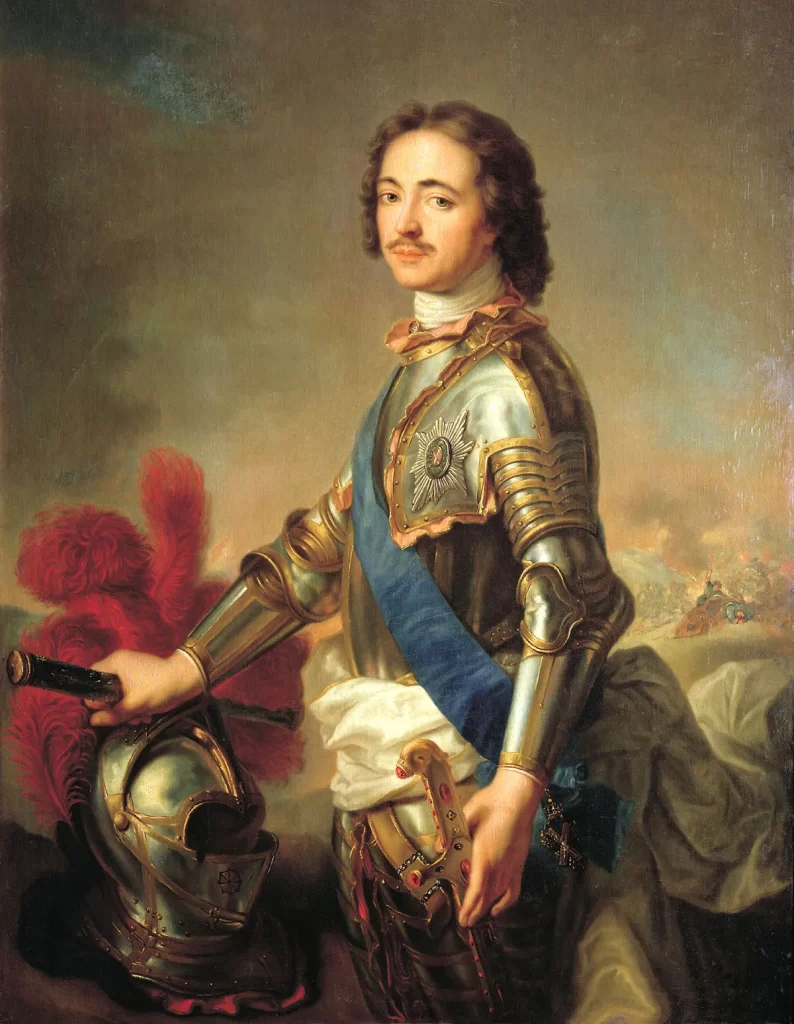
Peter the Great on Wikipedia
11:45 Hermitage Theater
“What an impressive orchestra! They must be Europeans!” “No, they’re Russian musicians.”

The film jumps almost to 50 years after Peter the Great: this time it’s Catherine II, so-called as Catherine the Great, and her theatre in focus. She is one of the most influential rulers in the history of the Russian Empire and an ambitious patron of arts acquiring works of European grand masters to her own collection. When I heard that she constructed roller coasters, so-called Russian mountains, at her palace in Oranienbaum during my visit out there, I have already understood that she was a cheerful personality who liked entertainment. And here in the film, in line with her dynamism and colourful personality, she concludes one of the shows in her theatre, runs up to the foyer and then disappears after leaving from its door.
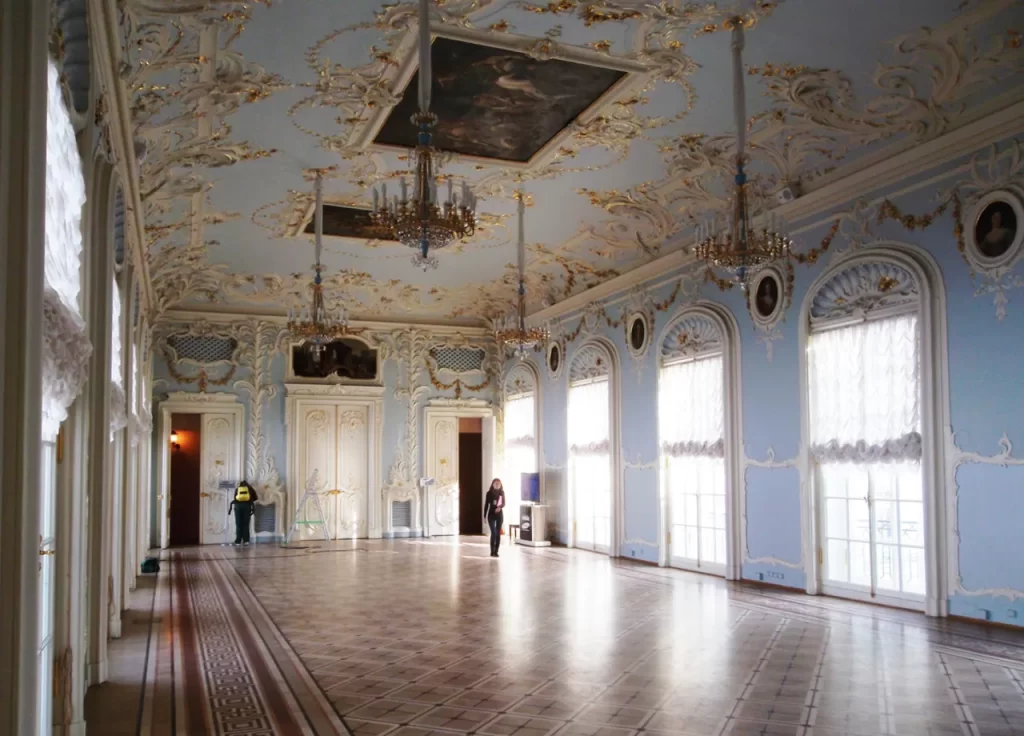
Hermitage Theatre was designed by Italian architect Giacomo Quarenghi as the private theatre of Catherine the Great. Constructed between 1783-89, this is one of the oldest theatres in Saint Petersburg. As a Russian theatre with a European touch, it served as a stage for several Russian and European plays of the time and hosted many elite guests from the Russian society. Today, the Hermitage Theatre continues to welcome audience for its classical ballet shows like Swan Lake and Nutcracker.
Check out Hermitage Theatre on Wikipedia, Hermitage Online and Hermitage Virtual Visit
More information on Catherine the Great and Russian Mountains
See the current programme of Hermitage Theatre
15:40 Raphael Loggias
“This seems like the Vatican. Is that where we are?”
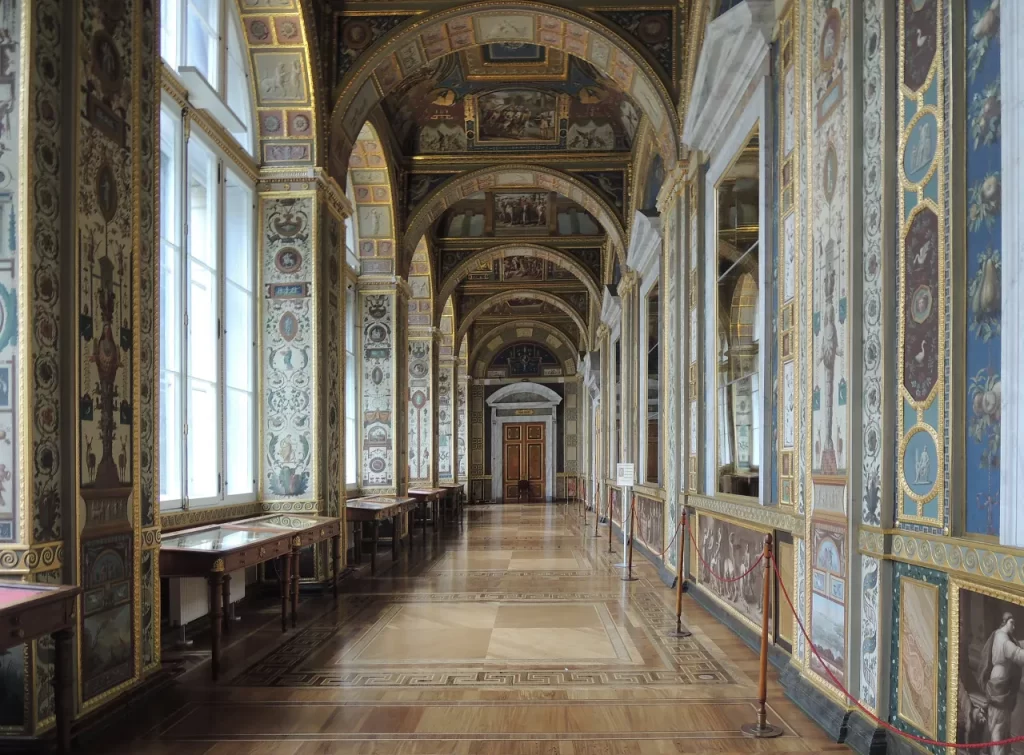
Our Hermitage tour starts with Raphael Loggias at the New Hermitage section. This is the replica of a loggia (a corridor supported by columns and arches) that was painted by Raphael for the Vatican in the 15th century. The replica in Hermitage was created for Catherine the Great in the 1780s by Italian architect Giacomo Quarenghi. And it was painted by a group of artists led by Italian painter Cristopher Unterberger. Raphael Loggias is one of the most impressive examples in Hermitage demonstrating how the European art, architecture and culture was excitedly embraced and even replicated by the Russian imperial palace.
Raphael Loggias on Hermitage Online and Hermitage Virtual Visit
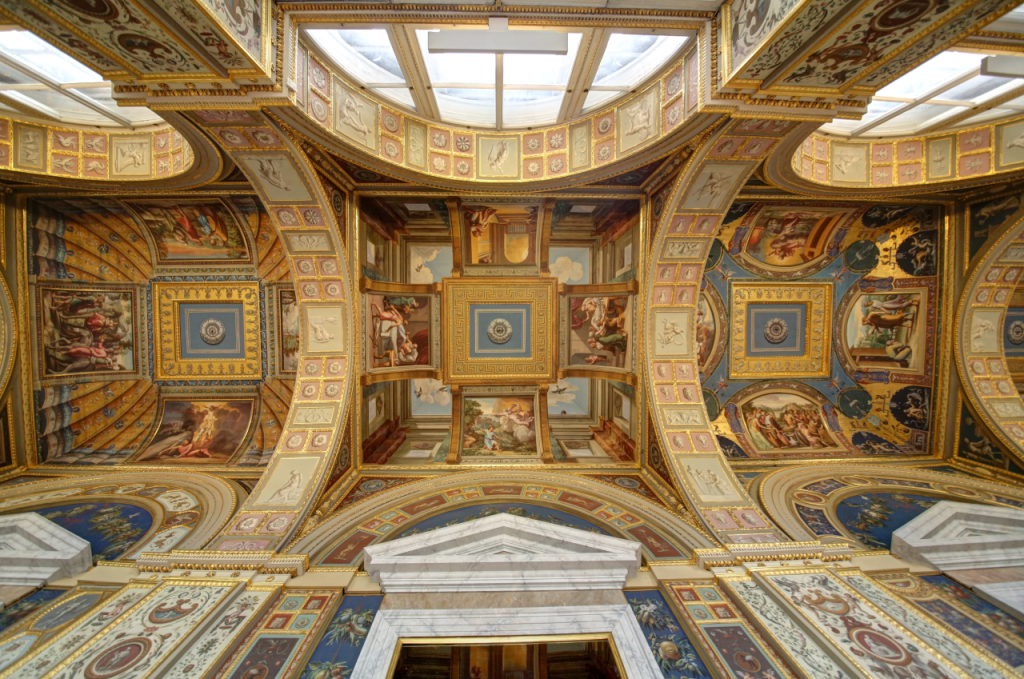
17:35 Small Italian Skylight Hall
“The Small Italian Gallery… Who are these people?” Did you notice the shift in time where our European character enters the Small Italian Skylight Hall? From the theatre play at the imperial palace in 18th century, all of a sudden we find ourselves in a museum setting full of visitors curiously looking at the Italian paintings. So we are back to Hermitage as today. The Small Skylight Room is an enormous hall lit from above. It displays Italian paintings from the 16th-17th century including Veronese and Tintoretto. It’s a part of the New Hermitage section designed by German architect Leo von Klenze upon the invitation of Tsar Nicholas I in the 19th century.
Check more about this room on Hermitage Online and Hermitage Virtual Visit
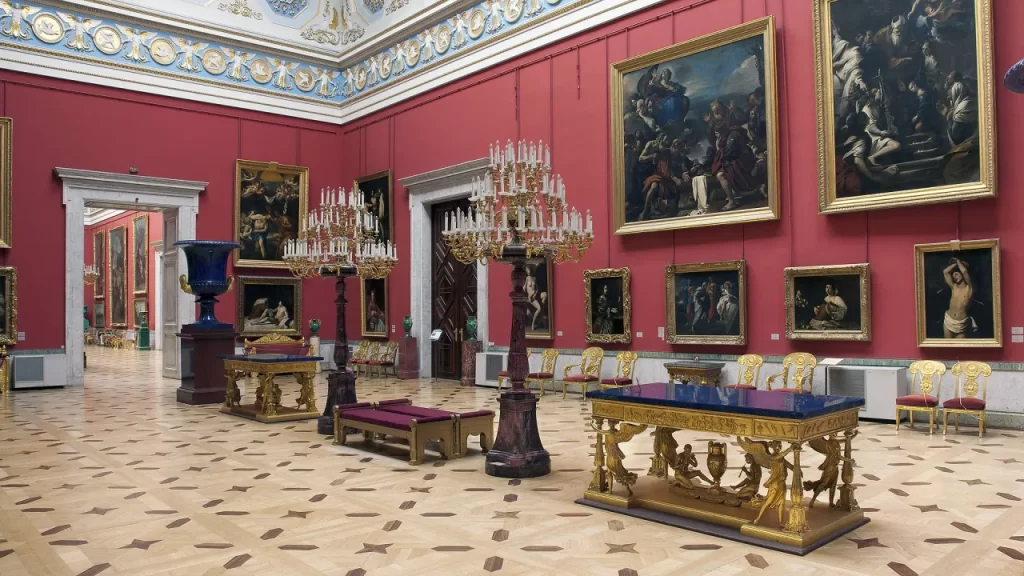
Our European character talks to three other men over a painting telling a Biblical story: “Birth of St John the Baptist” by Jacopo Tintoretto from the 1550s. This painting was one of the first paintings from European great masters in the collection of Catherine the Great. It was acquired from the French Baron Crozat’s collection by the 1770s. While visitors are fascinated about the room and artworks, the European character isn’t much convinced about how European art is brought, copied and displayed out there.
More about this painting on Hermitage Online

22:40 Gallery of the History of Ancient Painting
“My god! What is all this? Mother! Canova! What an elevated approach to art! What feel for the material! How wonderful!” The Gallery of the History of Ancient Painting is also a part of the section called New Hermitage designed by German architect Leo von Klenze. Its walls are decorated with paintings to attract attention to the history of ancient art with reference to Greek myths.
More about this gallery on Hermitage Online and Hermitage Virtual Visit
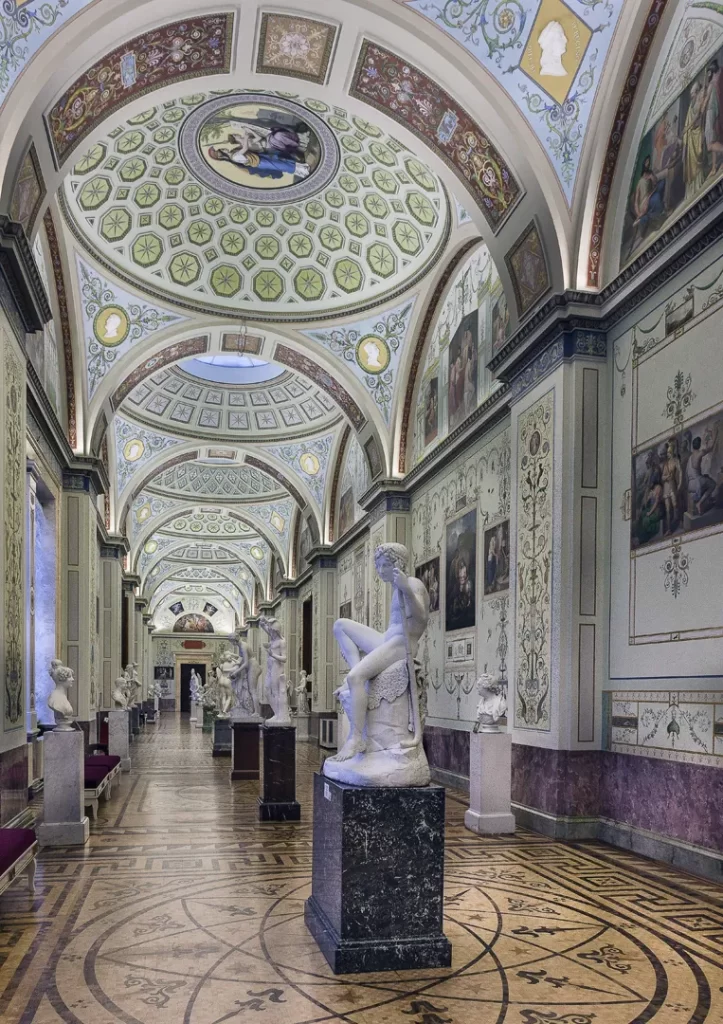
The gallery displays the works of Italian Neoclassical sculptor Antonio Canova. As the film’s European character mentions, Canova’s works were flourishing just at the time where the relations between France and Russia was going up and down. And they became a kind of object for dispute. Most of the works of the sculptor in this hall were originally in the collection of Napoleon’s wife Josephine de Beauharnias in the Castle of Malmaison near Paris. Some of them were gifts to her from her husband. After Russian emperor Alexander I entered Paris with his troops, he purchased this collection for Hermitage.

The Three Graces sculpture is a late work by Canova from 1813-1816. It was acquired in the Hermitage collection also a bit later on in 1901. It’s a perfect example of how Canova expresses the ideal beauty.
More about this sculpture on Hermitage Online
27:15 Van Dyck Hall
“The Virgin with Partridges by Van Dyck. Catherine II acquired it. Tell me about this painting. Please, tell me.”Walking from the gallery with Canova’s sculptures, the European character passes through the main staircase of the New Hermitage (with a quick glimpse of Pushkin passing by, so we should be now around 1830s). And that’s where he meets the blind lady with a deep passion for art. Together, they end up at the Van Dyck Hall where 24 masterpieces of the Flemish great painter are displayed.
More about this room on Hermitage Online and Hermitage Virtual Tour
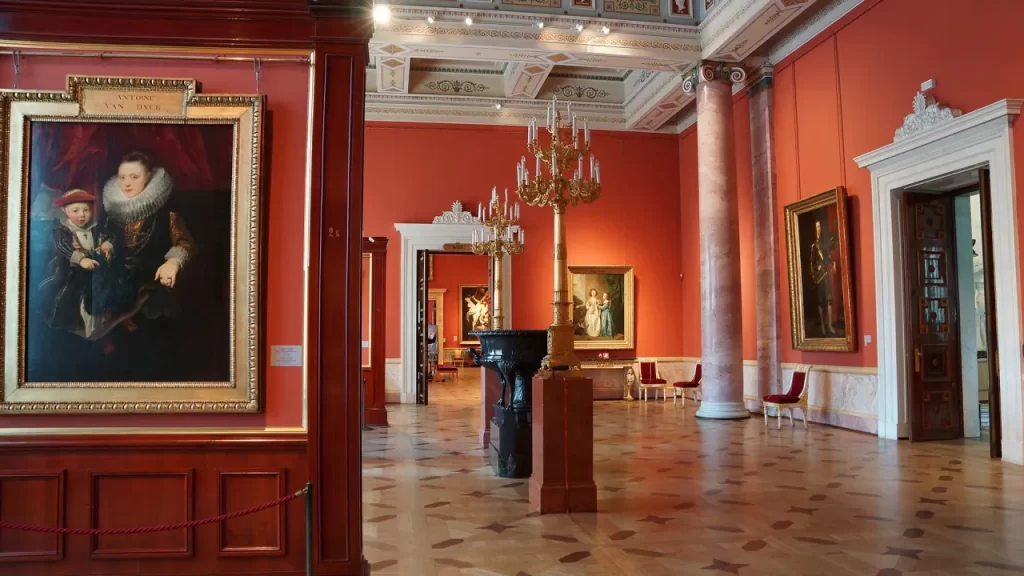
The lady interpreted the symbols at the painting “Rest on the Flight of Egypt (Madonna with Partridges)” from 1627: “The apple tree represents life. Sunflowers stand for piety. On the upper right, partridges symbolise frivolity.” The painting depicts the Biblical scene of Joseph and Virgin Mary fleeing into Egypt with infant Christ with a mix of spirituality and secularity.
More about this painting on Hermitage Online

29:00 Rubens Hall
“What a wonderful scent… The scent of oils…”
The exchange between the European character and the lady takes place in the Rubens Hall, which covers over 40 paintings and sketches by the Flemish artist Peter Paul Rubens. Most of the works here were acquired by Catherine the Great from the collection of Sir Robert Walpole, Prime Minister of England in 1779. More about this room on Hermitage Online and Hermitage Virtual Visit
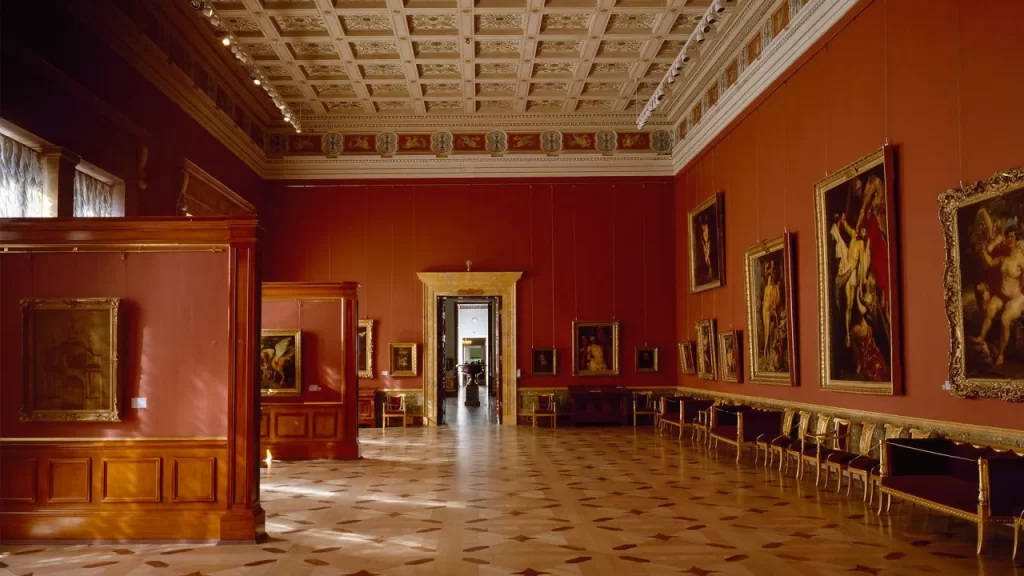
The film highlights “Feast in the House of Simon the Pharisee” painted by Rubens somewhere between 1618 and 1620. This is just during the period when van Dyck worked in the workshop of Rubens, so the former also worked on the creation of this painting.
About this painting on Hermitage Online

34:06 Tent Roofed Hall
“Eternal people… Live and go on living…” And finally we end up in the Tent Roofed Hall with its ornamented pitched roof and 17th century paintings mostly by the “Small Dutch Masters”. These painters are specialized in different types of paintings such as landscapes, interiors and still life. And the paintings are typically “small” in size to decorate the walls of Dutch houses.
More about the room on Hermitage Online and Hermitage Virtual Visit
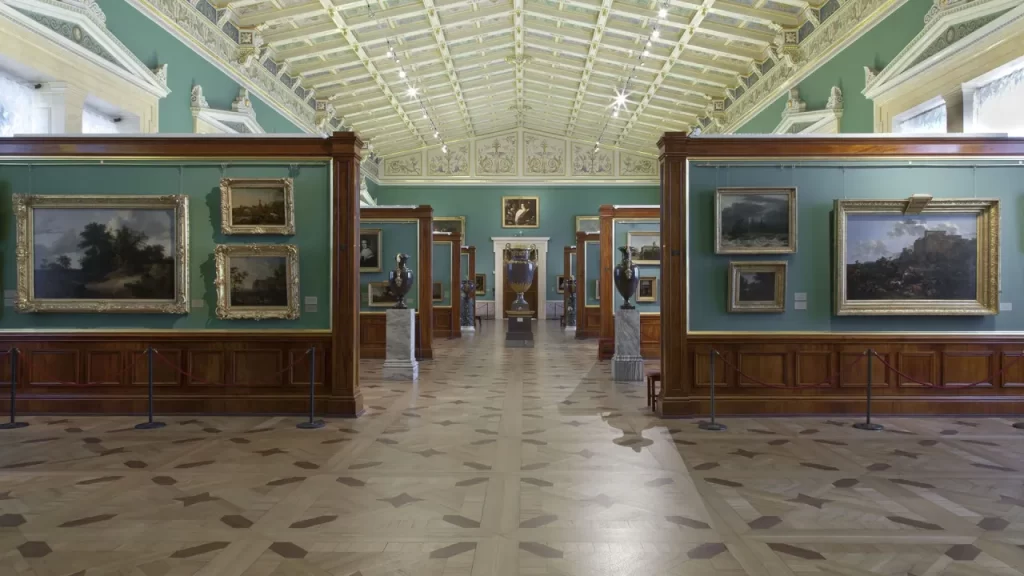
One of the highlights of this room is “Lady at Her Toilet” by Frans van Mieris the Elder, which is indeed a painting full of life. It depicts a daily scene full of hidden details: a letter on the table, untidy bed and elegant slippers on the side, some left overs from love and intimacy.
More about this painting on Hermitage Online
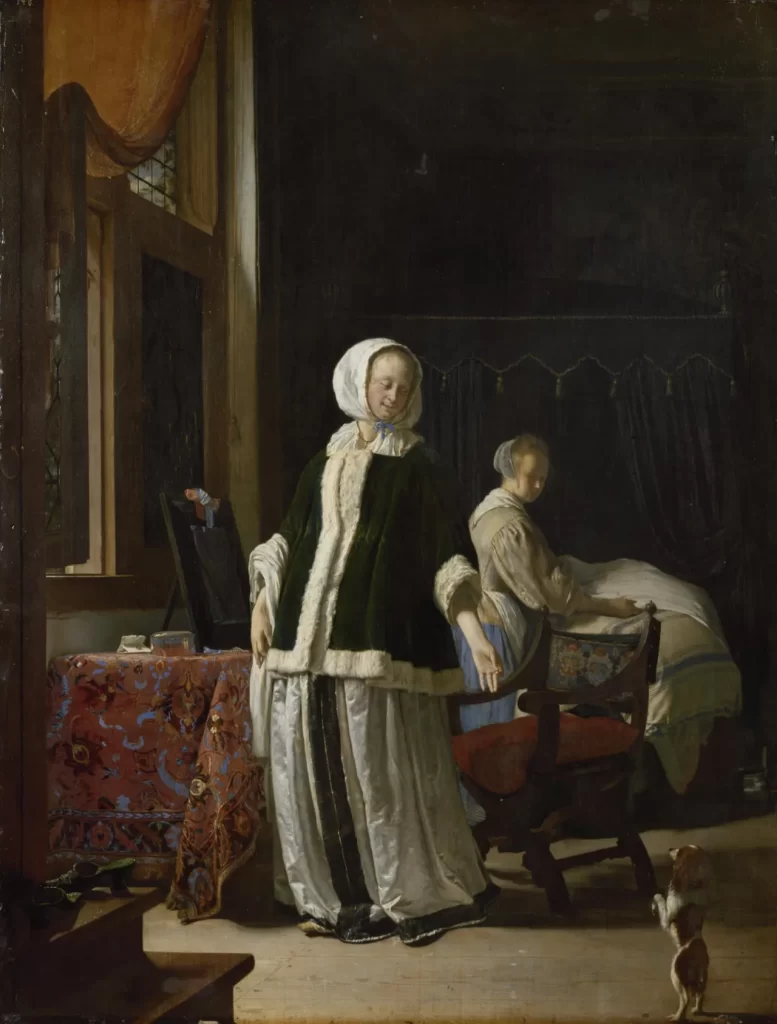
36:08 Spanish Cabinet
“Do you know that those are the apostles Peter and Paul?” “Yes, that’s what I heard. “That’s what you heard. And so?” “I looked at them because I like them.” This is a small room displaying the works of Spanish artists of the 15th to 17th century.
More about this room on Hermitage Online and Hermitage Virtual Visit
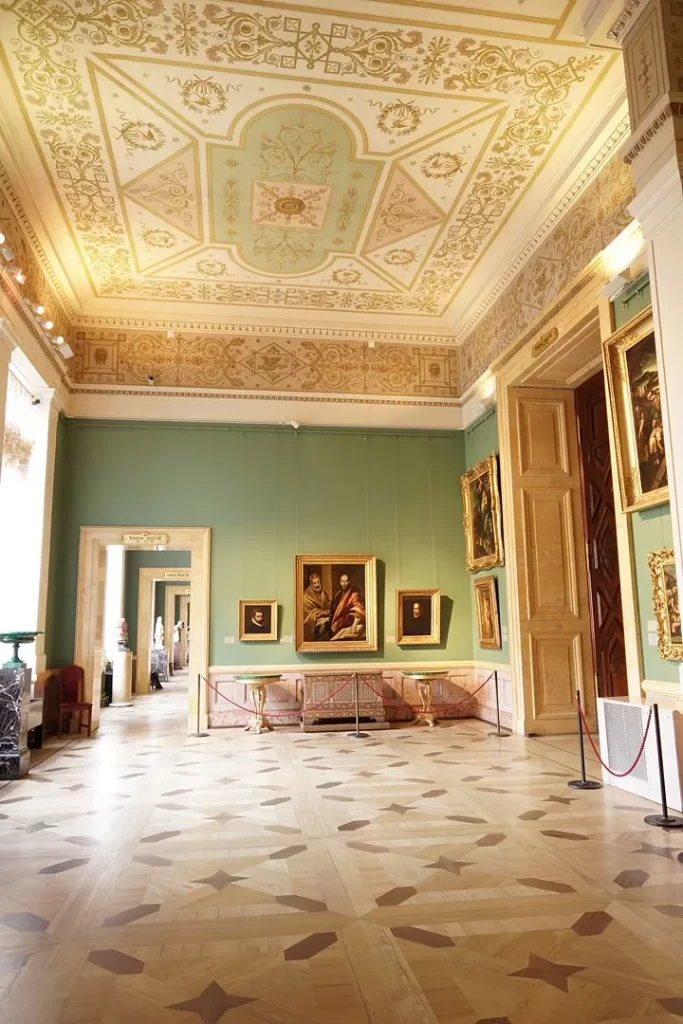
And the film highlights Saint Peter and Saint Paul by El Greco, the Greek painter of the Spanish Renaissance. One of the examples of El Greco’s strong expression about human condition: Peter on the left is seen in more pale colours in a more calm and passive mood, while Paul on the right has brighter colours with a more dynamic and bold attitude. Looking into further details, you can see the “key for the kingdom of heaven” at the left hand of Peter and the “letters for the New Testament” in front of Paul.

In his little conversation with the young boy looking at this painting, the European character teases him with questions and implying that sometimes one looks and believes without knowing and reading. This is the only painting, the place of which was changed for the film, to keep the intended route. While almost all the rest of the artworks are at their usual place.
More about this painting on Hermitage Online
40:00 Rembrandt Hall
“Sometimes I prefer speaking to myself. This painting and I… we have a secret.” The Rembrandt Hall is a place where one can spend hours looking into the details of the great master’s portraits. Especially the facial expressions and deep wrinkles of the old people he portrayed, but also others full of other feelings – sorrow, embarrassment, fear, hope…
More about this hall on Hermitage Online and Hermitage Virtual Visit

And one of his masterpieces is “Danaë” from 1636, where in the film a lady speaks to herself gazing at the painting. This painting depicts a typical scene of the Greek myth of Danae being shut in a tower and Zeus reaching to her with a shower of gold. Did you know that this painting was severely damaged by vandalism and it took almost 12 years to restore and display it to the public?
More about this painting on Hermitage Online
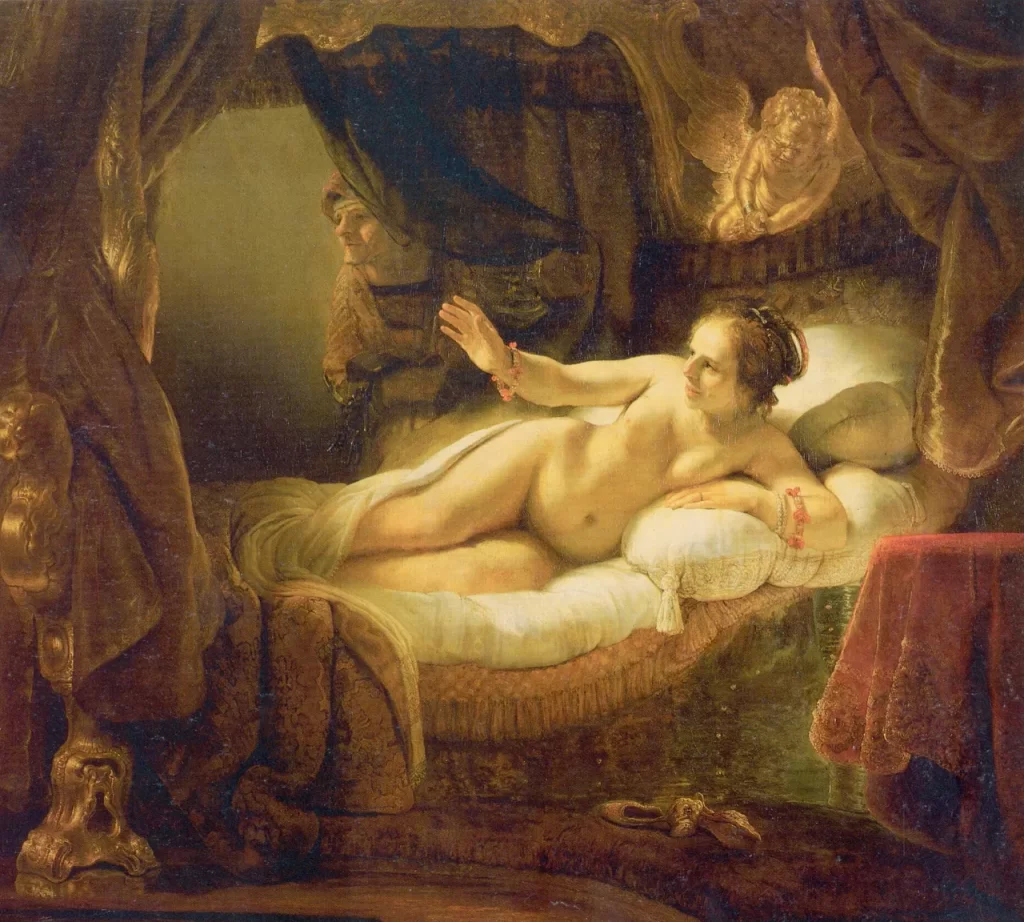
And you’ll see two other masterpieces in focus before the camera leaves the Rembrandt Hall, such as: “Sacrifice of Isaac” painted around 1636. A very dramatic and emotional scene of Abraham sacrificing his son Isaac to show his faith and an angel preventing him at the last moment.
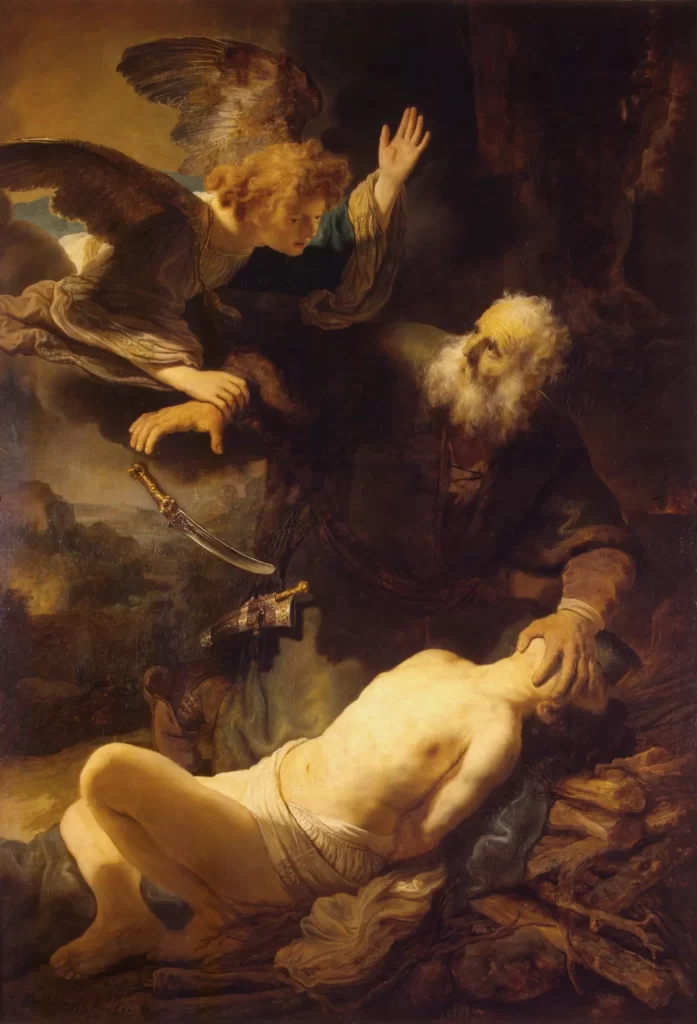
The “Return of the Prodigal Son” that Rembrandt painted around 1668, in the final years of the painter’s life. A very intimate scene of the son coming back home and taking shelter in the forgiveness of his father.

47:00 Council Staircase
“When you first came here it must have been disastrous… That was just after the fire.” In the film, the passage from the Rembrandt Hall to the Council Staircase brings another shift in time: from Hermitage as a museum with curious visitors in the 21st century, to Hermitage as a palace with guards in the 20th century. This Council Staircase full of marble flooring, columns, wall and sculptures has a strategic location connecting different sections of the Hermitage complex that were constructed at different periods: Small, Old and New Hermitage.
More about the Council Staircase onHermitage Online and Hermitage Virtual Visit

The Upper Landing of the Staircase by Eduard Hau, 1860. Image credit
The fire mentioned in the film was a great event that occurred in 1837 at the Winter Palace, the main building of the Hermitage Museum. It lasted for a few days and destroyed the major halls in the palace, which were completely restored after the fire.
Read more about this great fire on Hermitage Online
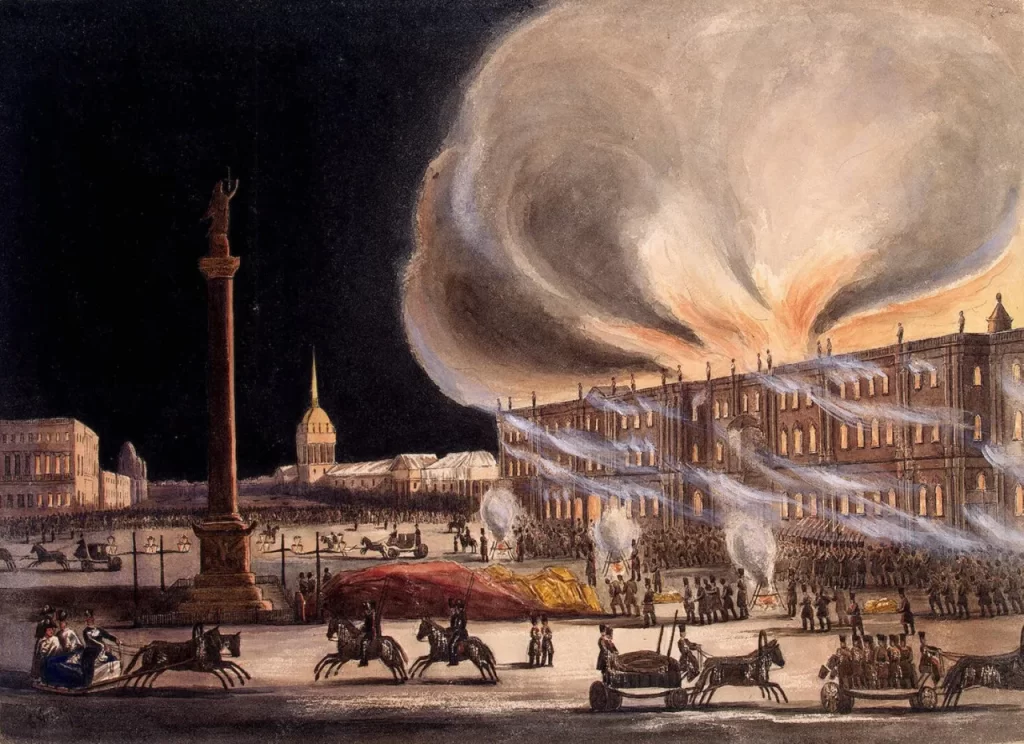
Fire in the Winter Palace by Boris Green, 1838. Image credit
49:00 German Art of the 15th-18th Centuries
“In the 20th century, Russia was at war with Germany. The Germans surrounded the city. But the city did not surrender. More than one million dead.” “That’s a high price to pay. Very high. Saint Petersburg and the Hermitage paid dearly.” “In Russia, it is said that freedom has no price.” Escaping from the palace guards, the European character bumps into a totally unexpected moment: a room full of empty frames, a man fabricating coffins and a snow spraying into the room. This is the time of the Leningrad Siege, where Soviet city of Leningrad (today’s Saint Petersburg) was put under a blockade by the Nazi Germany for almost two years between 1941-1944. During this time, the artworks in the Hermitage were evacuated and moved to Urals for protection. That’s why you can see empty frames all around. Here’s one of the photos from that time.
More about the evacuation of Hermitage during the World War II on Hermitage Online
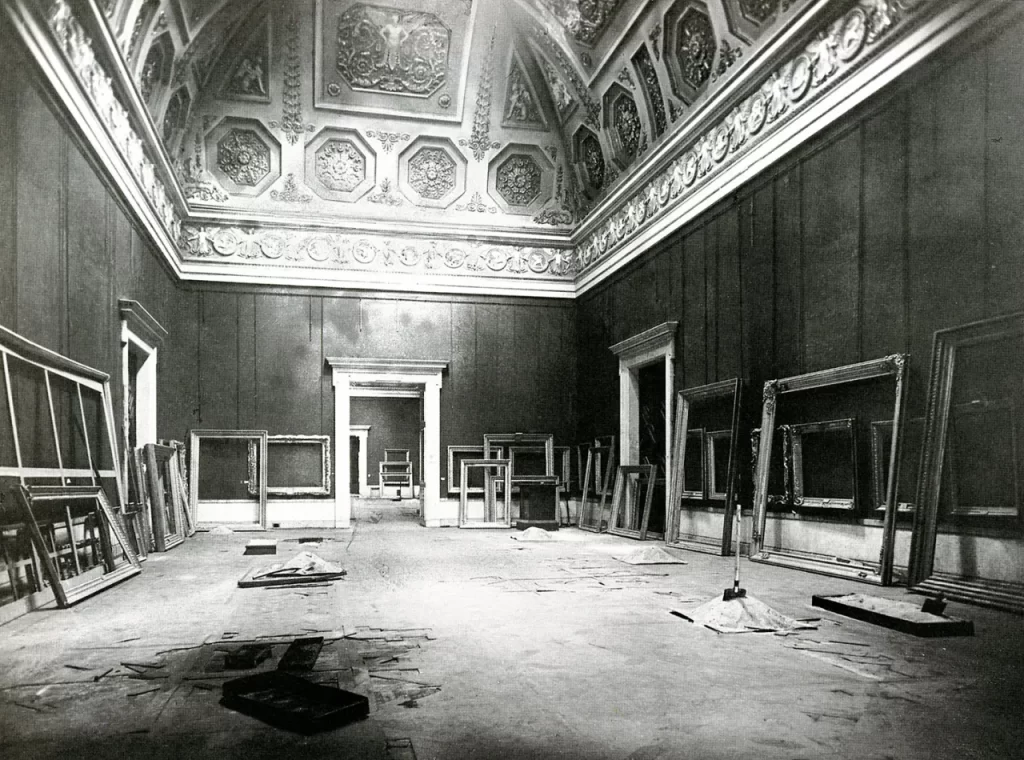
This scene is set in the room which houses 15th-18th century German art at today’s Hermitage. It’s not necessarily the room in the previous original photo, as the German art room is just used for the film scene.
More about this room on Hermitage Online and Hermitage Virtual Visit
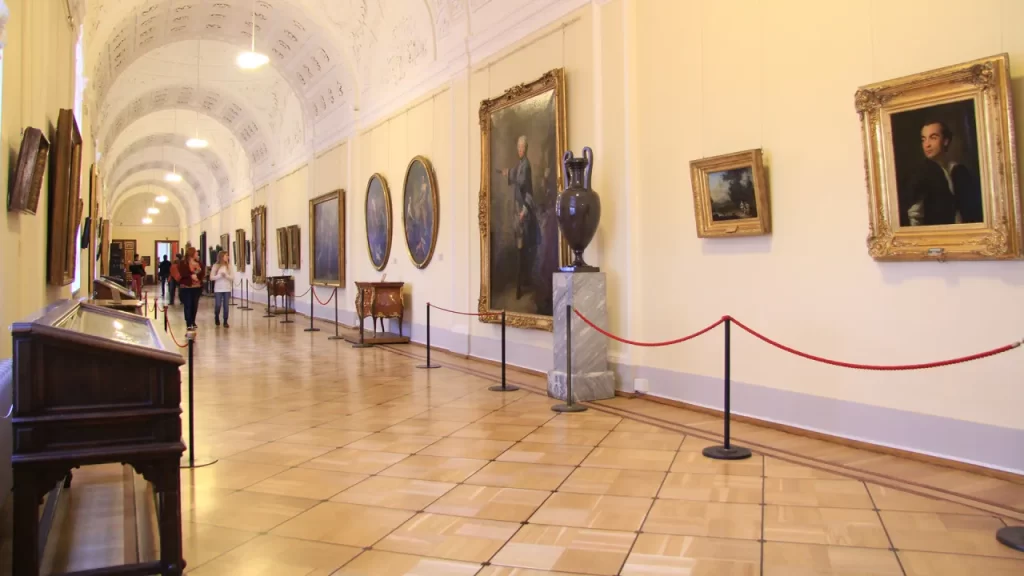
51:35 Pavilion Hall
“If it’s Catherine, she has a sixth sense…” The film jumps from the 20th century back to the 18th century right at the Pavilion Hall, where Catherine the Great at her later ages is seen with children. The Pavilion Hall is a large and bright room with marbles, chandeliers, fountains and mosaics. It looks at the Hanging Garden, which is enclosed by buildings. This is where Catherine the Great is seen as walking and disappearing under the snow.
More about this hall on Hermitage Online and Hermitage Virtual Visit
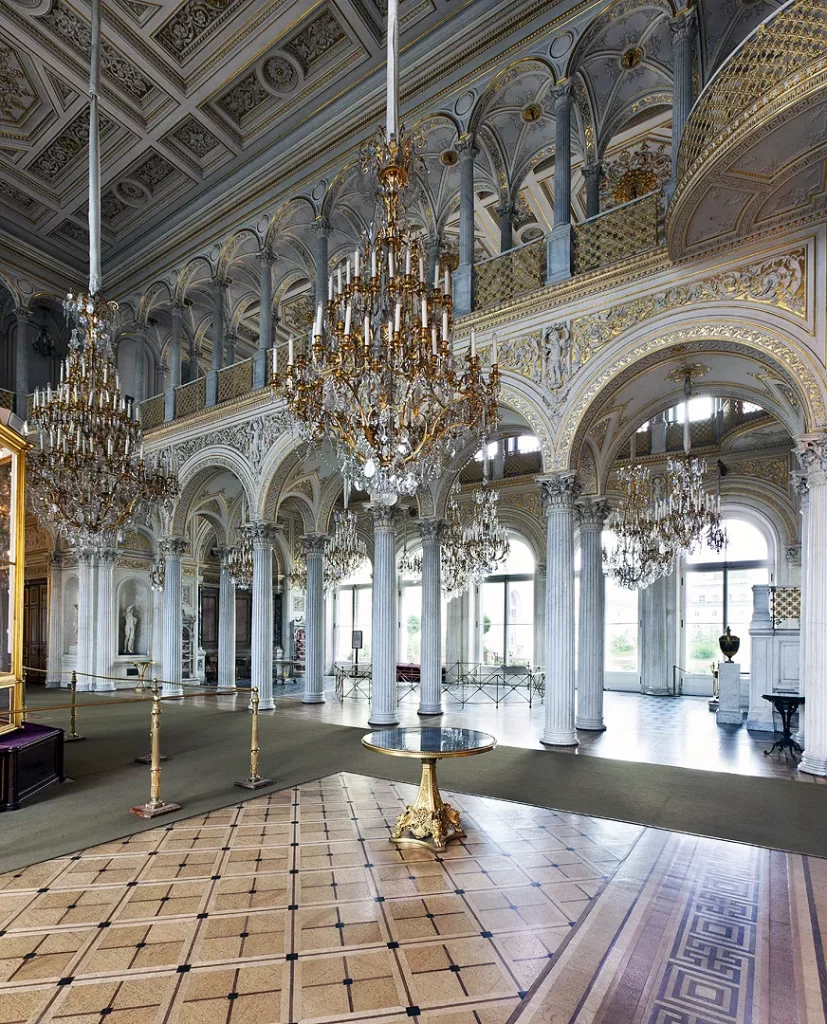
54.12 St George Hall
“When I was last received here at the Winter Palace, it was being renovated after the terrible fire”. St George Hall, also known as the Large Throne Hall, is one of the impressive halls of the Winter Palace that hosted official ceremonies and receptions. Originally created by Italian architect Giacomo Quarenghi by 1795, it was destroyed by the great fire in 1837. Then, it was re-created by Russian architect Vasily Stasov in the 1840s. The parquet flooring highlighted in the film contains 16 varieties of wood.
More about this hall on Hermitage Online and Hermitage Virtual Visit

St George Hall by painter Konstantin Ukhtomsky.
In the film, St George Hall hosts an official ceremony where Prince Khoshow Mirza, the grand son of Persian Shah, apologizes to Nicholas I for the murder of Russian ambassador to Persia Alexander Griboyedov and other diplomats (an event that took place in 1829). The Emperor stands in front of the great imperial throne, which was made in London in 1732.
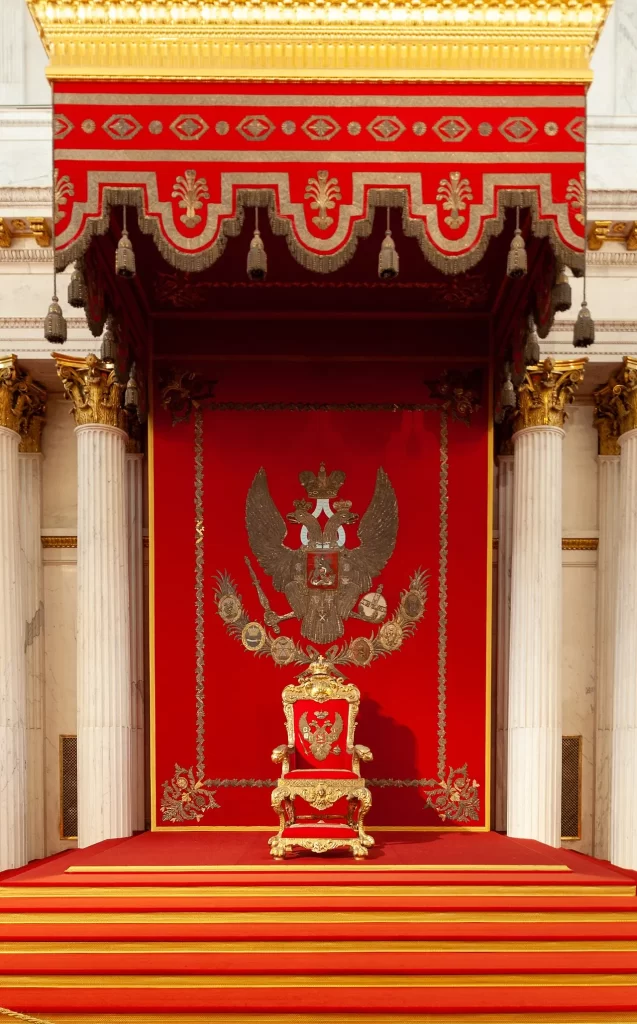
1:03:35 Armorial Hall
“Stasov wasn’t a bad architect. He loved discipline, but left space for breathing”.
And here’s the Armorial Hall, where in the film there’s an ongoing preparation of a reception for the guests to arrive after the ceremony in the St George Hall. Like the St George Hall, the Armorial Hall was also re-created by Russian architect Vasily Stasov after the big fire. This hall is characterised by the sculptures of Russian warriors, gold pillars and vast chandeliers.
The Armorial Hall by painter Edward Hau, 1863.
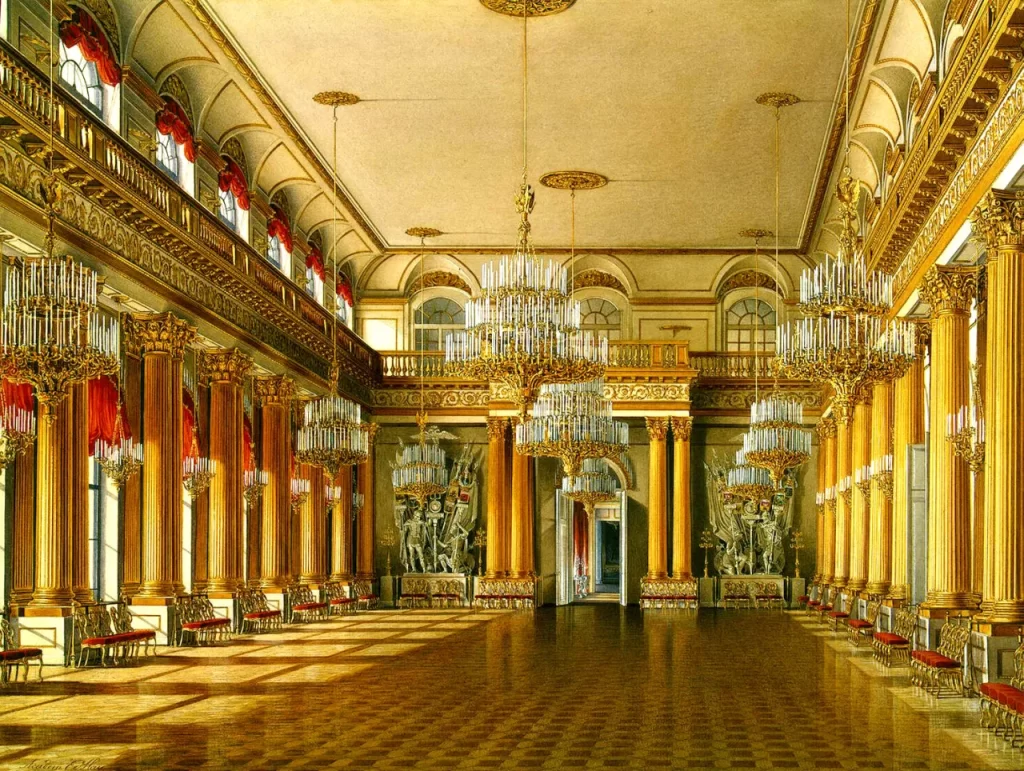

The Armorial Hall by painter Adolphe Ladurner, 1838. Image credit
1:05:30 Peter the Great Hall (Small Throne Room)
“The wars ahead… Terrible wars… But we managed to preserve all this through the catastrophes” From the grandiosity of the St George and Armorial Halls, now we step into a dark room: Peter the Great Hall, or so-called Small Throne Room. This hall was created in the memory of Peter the Great. It was designed by French architect Auguste Montferrand in 1833 and restored by Russian architect Vasily Stasov after the big fire. More about this room on Hermitage Online and Hermitage Virtual Visit
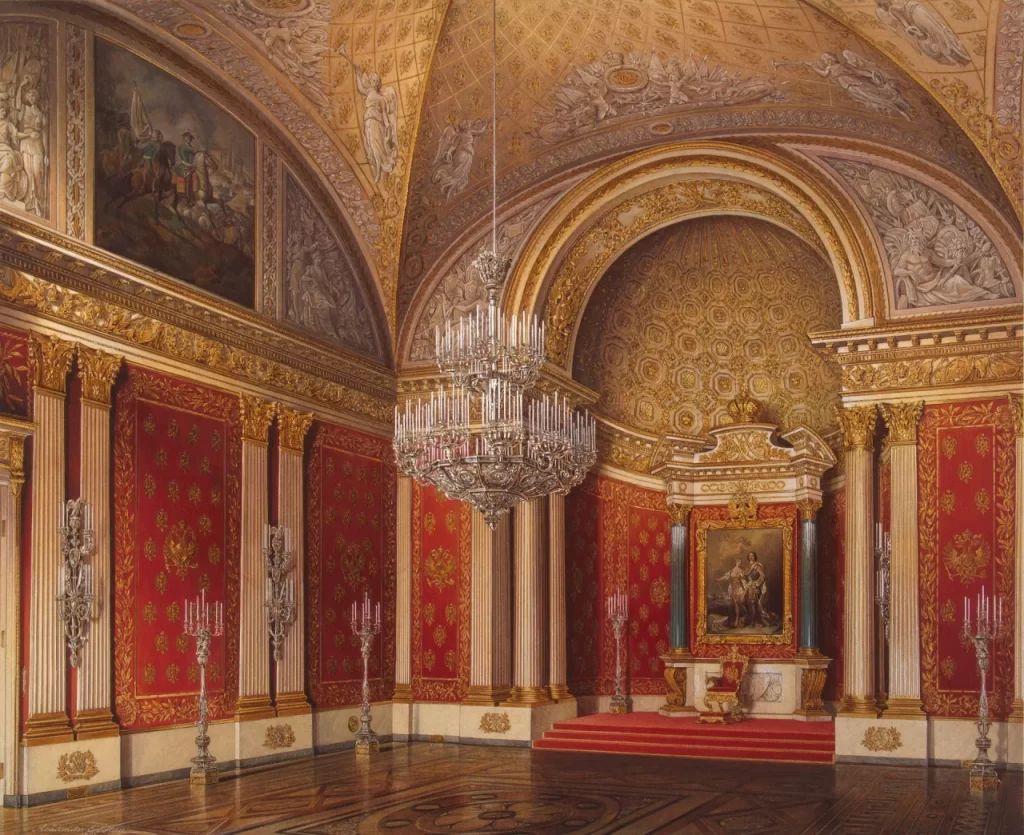
The Peter Hall by painter Eduard Hau, 1863. Image credit
Get ready to witness an intimate conversation between three different generations of Hermitage Museum Directors in this room: Joseph Orbeli (1934 to 1951 – with the beard), Boris Piotrovsky (1964 to 1990) and his son Mikhail Piotrovsky (1990 up until today – with glasses and playing himself in the film). Three influential personalities for the management of the museum at very turbulent times… Orbeli has seen the Stalin period of the Soviet Union when several artworks were sold in the 1930s to support the industrialization of the country. He was also the museum director during the Second World War when the museum artworks were evacuated to Urals to be protected from the Nazi German forces, during the famous almost 2.5-year-long Siege of Leningrad. While Boris Piotrovksy was the museum director for 40 years of the Soviet era. His son Mikhail Piotrovsky, who is still the current museum director, has seen the period after the dissolution of the Soviet Union and took a significant role in opening the museum collection to other countries. Isn’t it a very interesting experience to hear these three men talking about the destiny of their dear Hermitage Museum? And how do you feel about the time, when you come across these three generations of directors from different periods?
1:09:50 Field Marshals’ Hall
“Beautiful uniforms, even if I don’t like the military” Leaving the directors at the Small Throne Room, the camera jumps into a military ceremony in the next room: The Field Marshals’ Hall, which was built in the honour of Russian military officials that attained the rank of field marshal, the highest rank in the army. This is another room that was originally designed by French architect Auguste Montferrand in 1834 and was restored by Vasily Stasov after the fire.
Hermitage Online and Hermitage Virtual Visit
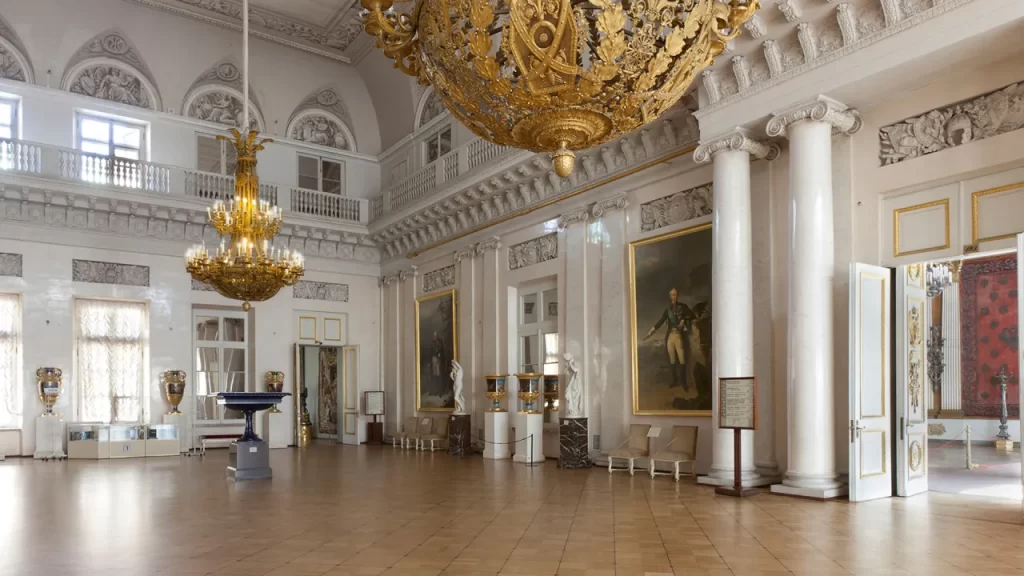
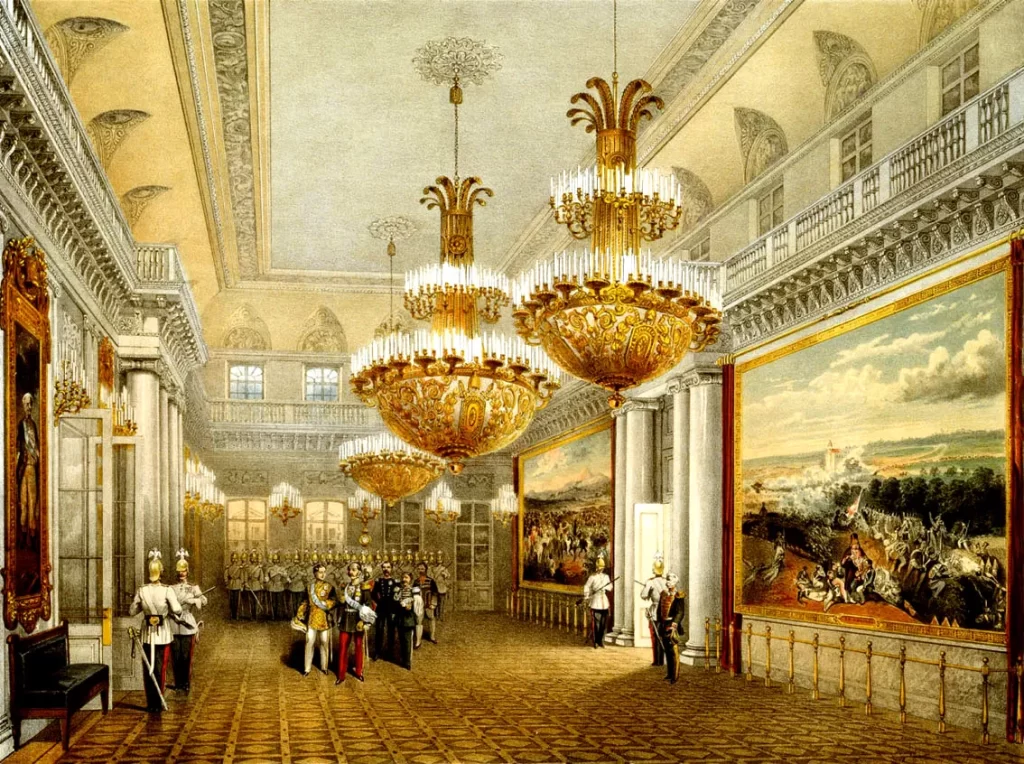
The Field Marshal’s Hall by painter Vasily Semyonovich Sadovnikov, 1852. Image credit
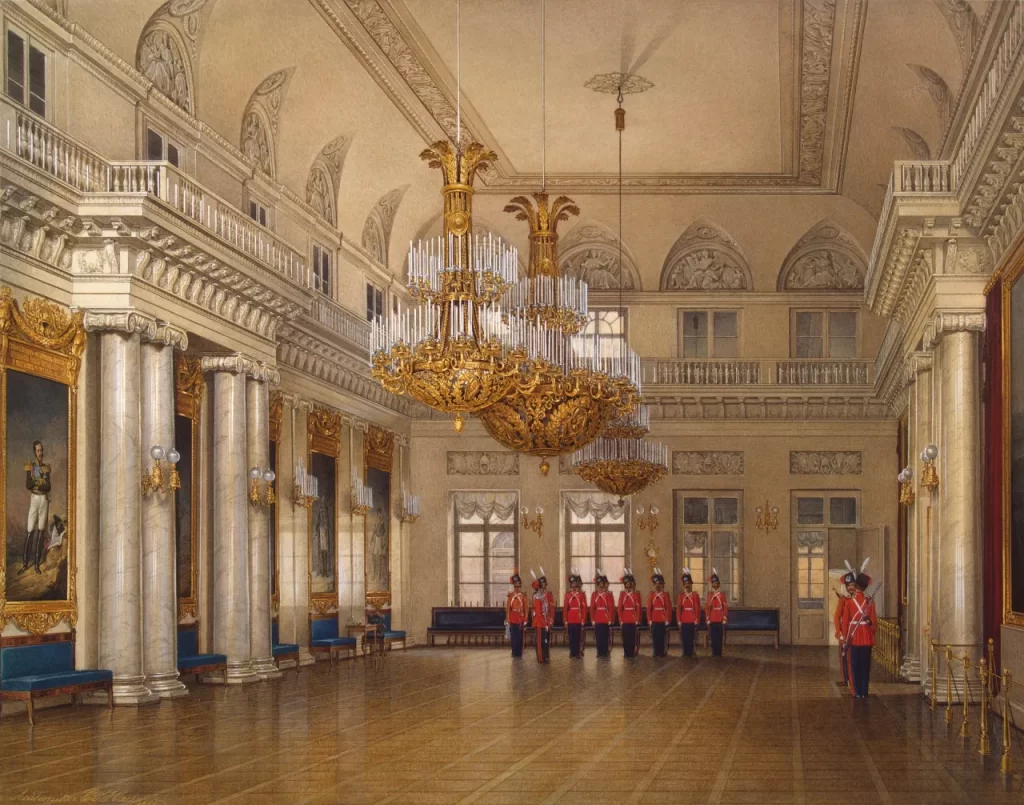
The Field Marshals’ Hall by painter Eduard Hau, 1866. Image credit
1:11:00 Portrait Gallery of the Romanov Dynasty
“Please don’t run! I can’t keep up with you… Little birds”Then the camera moves from this military ceremony to a rather intimate and daily imperial life at the time of Emperor Nicholas II. Five girls are seen running with joy through the long corridor of the Romanov Gallery. Among them is Anastasia, the youngest daughter of Empress Alexandra Fyodorovna and Nicholas II. Empress Alexandra is seen as walking non the same gallery with a nun and talking about her worries about the health of her son Alexei, who had a genetic condition called haemophilia. There’s a dramatic contrast between the running girls and this boy, who spent a rather restricted childhood.
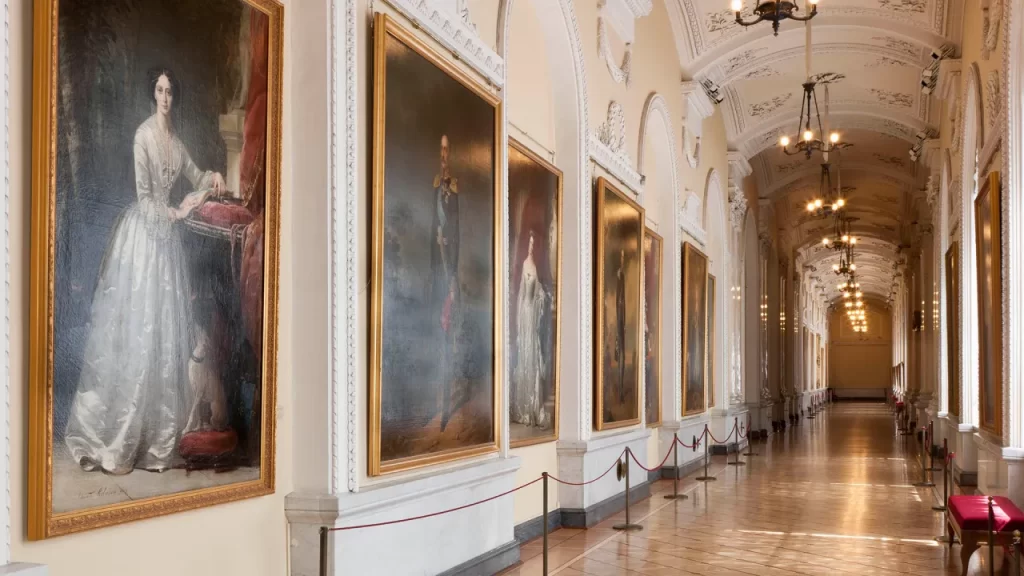
The Romanov Gallery displays the portraits of the dynasty members from Peter the Great, the founder of the Russian Empire in the 18th century to Emperor Nicholas II, its last emperor when the empire dissolved by the beginning of 20th century.
More about this room on Hermitage Online and Hermitage Virtual Visit
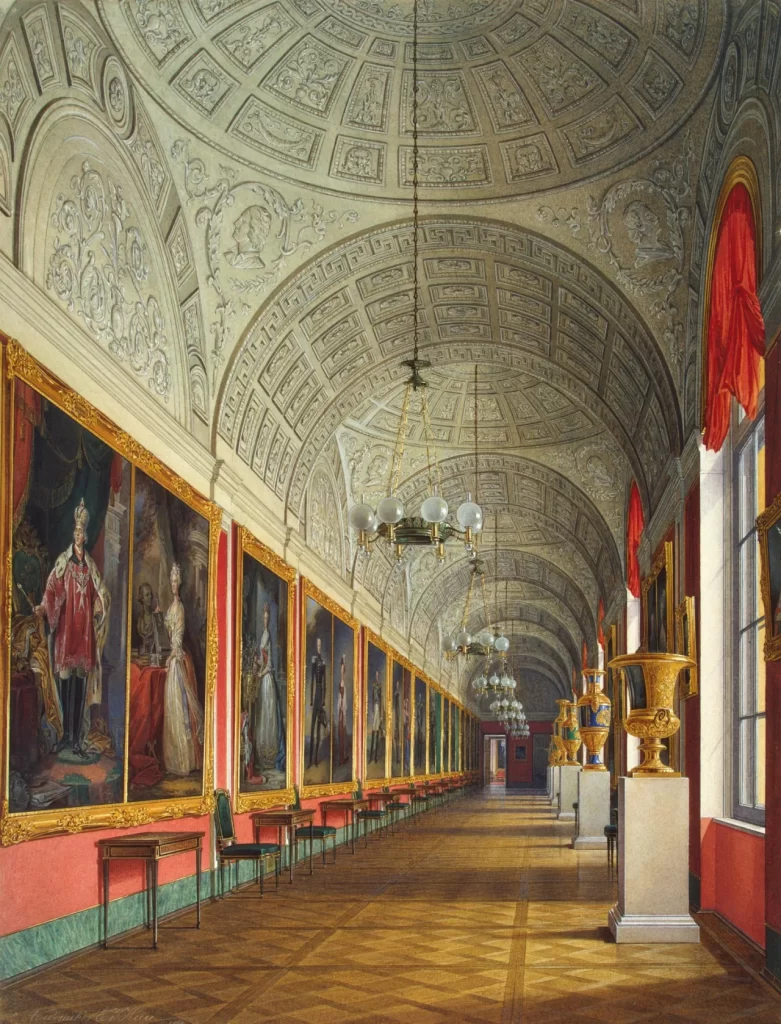
The Southern Part of the Romanov Gallery by painter Eduard Hau, 1864. Image credit
1:12:55 Small Dining Room
“You’re late for tea” Finally the whole family unites around the table in the Small Dining Room: Emperor Nicholas II is portrayed as a gentle family man serving tea and having an intimate moment with his family. It’s the same family who would be dramatically executed in 1918 during their exile in Yekaterinburg, a year after Nicholas II abdicated from the throne.
More about the execution of the royal family on Wikipedia
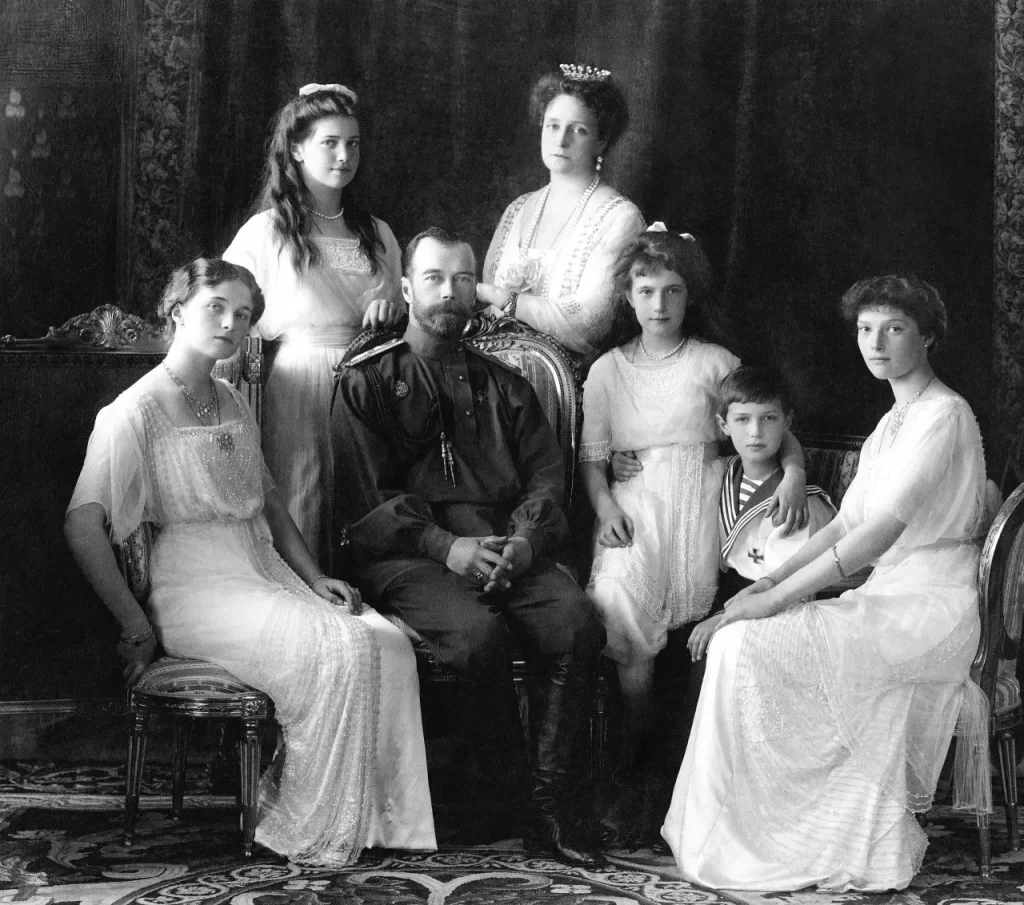
Nicholas II with the family (left to right): Olga, Maria, Nicholas II, Alexandra Fyodorovna, Anastasia, Alexei and Tatiana. Image credit
The Small Dining Room is seen with its elegant furniture and walls covered with Russian tapestries with moulded frames around them. The Russian Empire came to an end after Nicholas II left the throne and a provisional government was established. And during the October revolution in 1917, this Small Dining Room witnessed another striking event: the provisional government members were arrested by Bolsheviks who entered the Winter Palace, the main building of the Hermitage Museum.
More about this room on Hermitage Online and Hermitage Virtual Visit
1:14:45 Nicholas Hall
“Everyone is so easygoing… Like one big family”. The film concludes with a spectacular ball scene at the Nicholas Hall with elegant guests dancing with the live music of an orchestra. It’s the Mariinsky Theatre Orchestra conducted by Valery Gergiev that plays Mazurka from the opera of “A Life for the Tsar”.
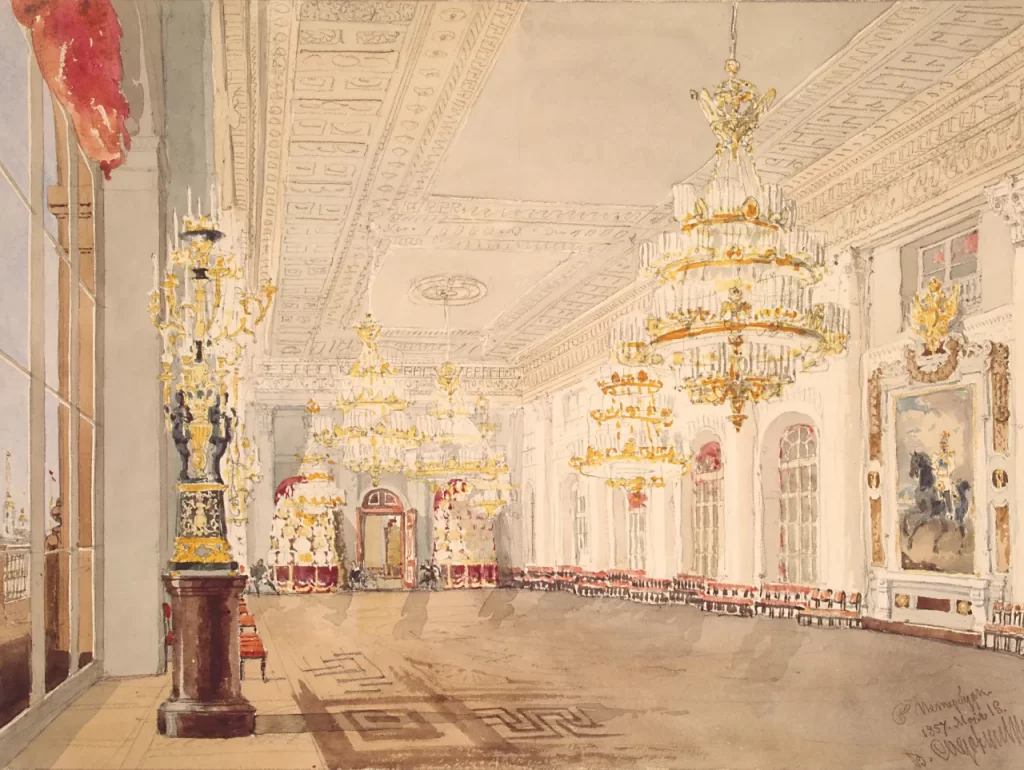
The Nicholas Hall by Vasily Sadovnikov, 1857. Image credit
The Nicholas Hall was created by Vasily Stasov after the great fire in 1837, replacing the previous halls designed by Italian architects in the 18th century. It was named after Nicholas I after his death in 1855. Together with a few other adjacent halls, the Nicholas Hall is a part of a processional route used by the imperial court for ceremonies and balls. It’s characterised by its enormous chandeliers, Corinthian columns, marble finish and unique parquet flooring pattern.
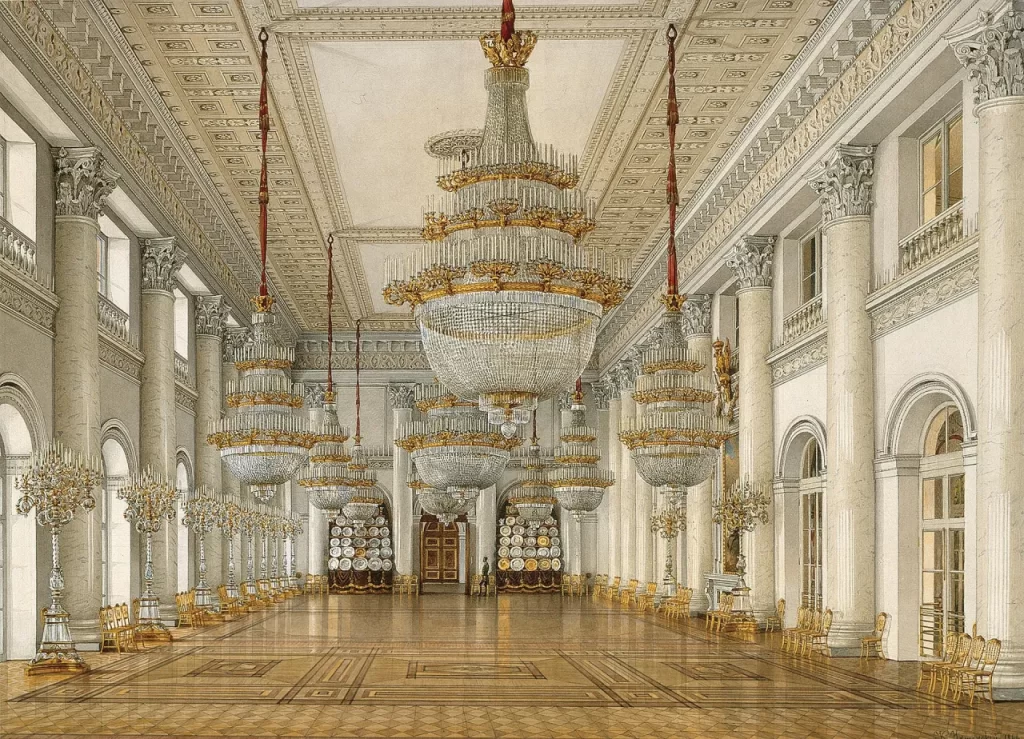
The Nicholas Hall by painter Konstantin Ukhtomsky, 1866 – Image credit
During the 1st World War, between 1915 and 1917, the Nicholas Hall was used as a hospital, while several other halls of Hermitage were used to support these medical facilities.
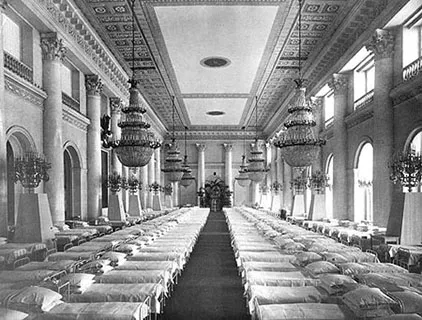
The culminating moment of the film comes when the ball ends and when, all of a sudden, all the dance, music, cheers and elegance comes to a halt and turns into silence, melancholy and surrender. A moment representing the end of the flamboyant imperial life at the palace and the start of a long and turbulent period in the Russian history. With this mood, guests follow this processional route by passing through the Forehall and arriving at the main staircase of the Winter Palace.
More about this hall on Hermitage Online and Hermitage Virtual Visit
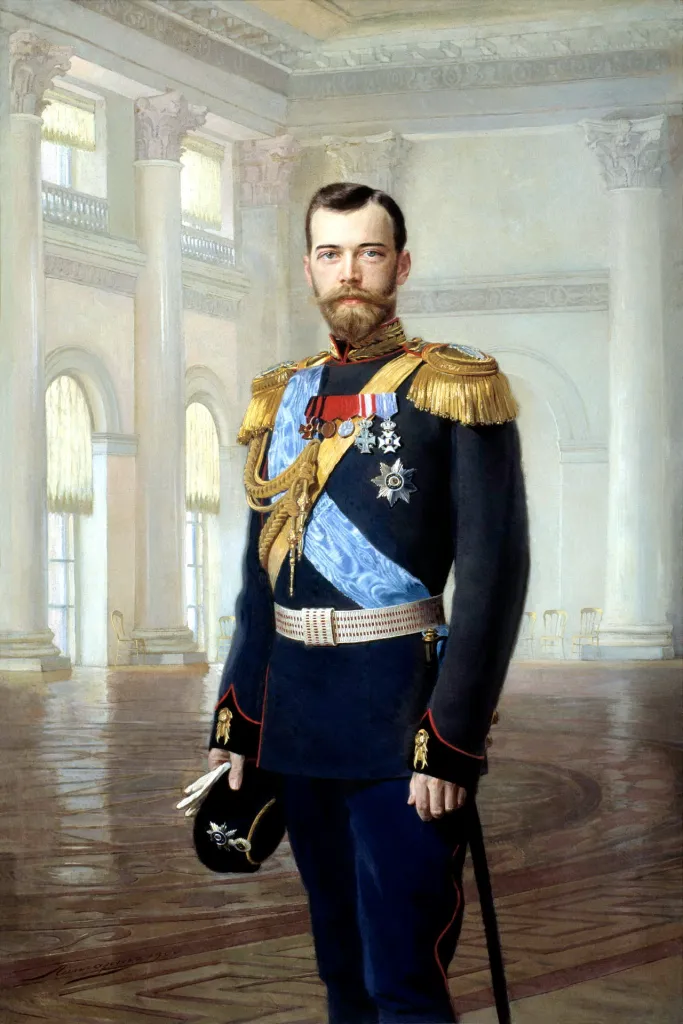
Nicholas II in the Nicholas Hall by painter Ernst Friedrich von Liphart, 1900s – Image credit
1:28:30 Main Gallery of the Winter Palace (Jordan Gallery)
The main staircase of the Winter Palace was designed by Italian architect Francesco Bartolomeo Rastrelli in the 18th century and was restored by architect Stasov after the great fire in the 19th century sticking to the original design. It’s also called Jordan Gallery in reference to the religious procession of the tsar through this staircase to the Neva River as a ceremony for the blessing of waters.
More about this gallery on Hermitage Online and Hermitage Virtual Visit
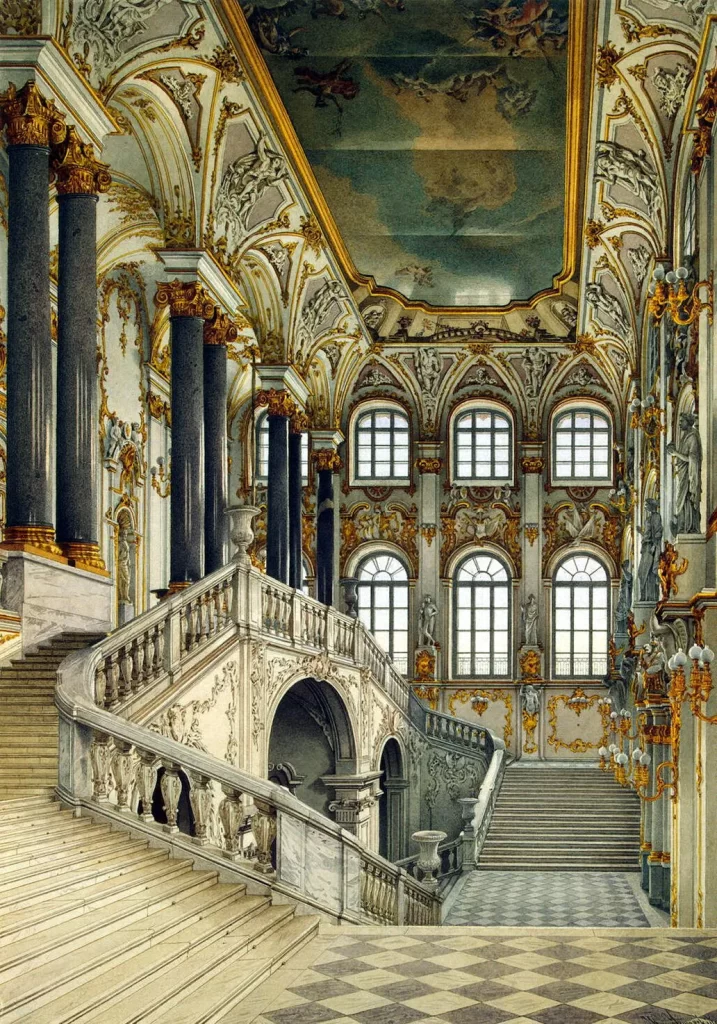
The Jordan Staircase by painter and architect Konstantin Ukhtomsky, 1866. Image credit
When you enter the Hermitage Museum from the main entrance at the Palace Square today, this is the staircase leading you to the exhibition halls upstairs. This is an amazing spot to enjoy but at the same time, almost always packed with tourist groups and other visitors flowing in and out through the museum. Here you can see some of the fine details of the gallery, especially the amazing painting on the ceiling painted by Gaspare Diziani and the richly decorated walls with sculptures.
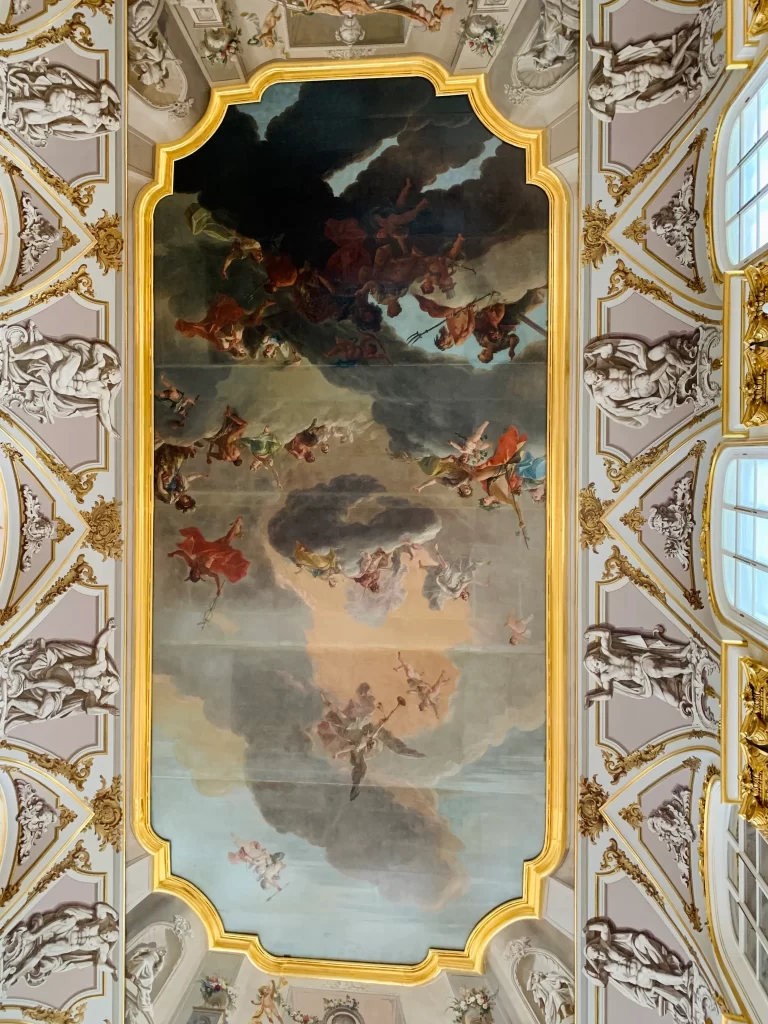


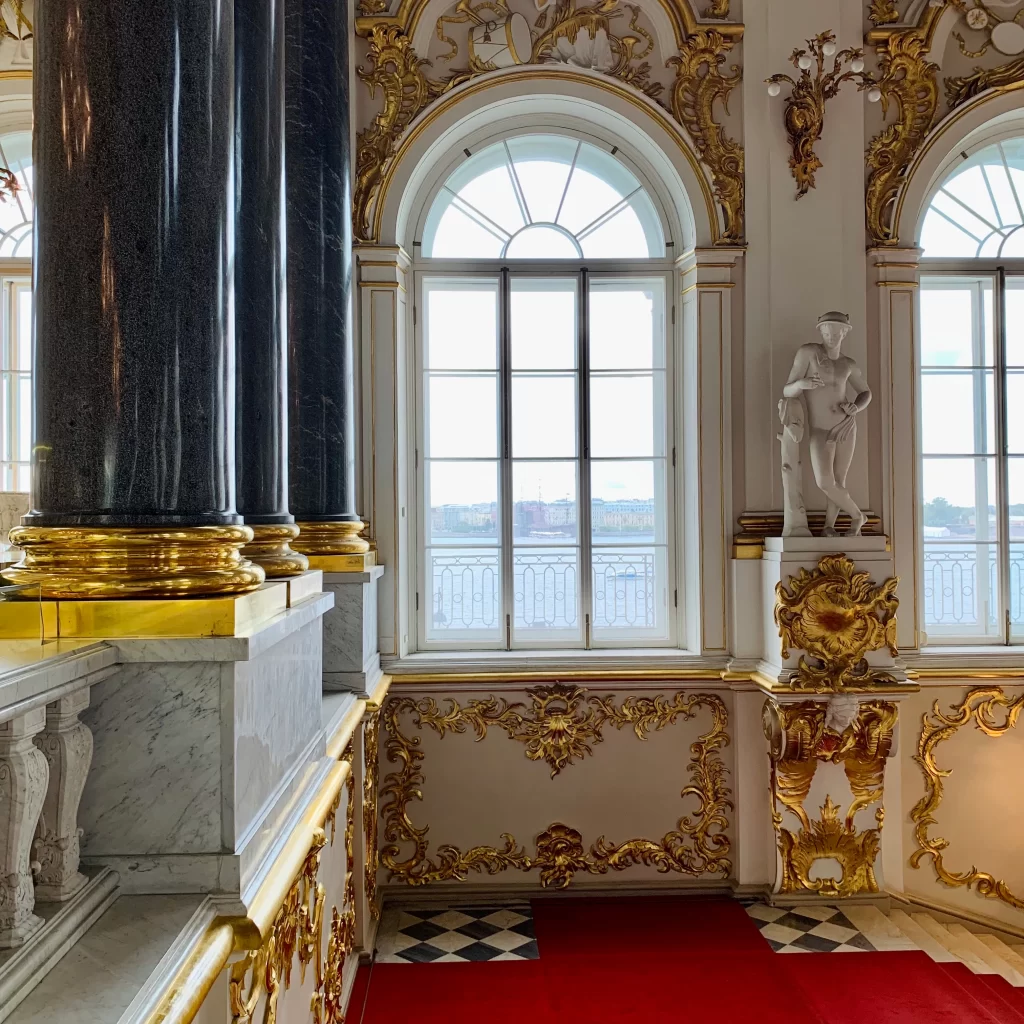
Details from the Jordan Gallery at Hermitage Museum today. Image credit
The Jordan Staircase is just the perfect place for ending the film: the crowd slowly flows outside Hermitage with one step at a time, with the glimpse of the Neva river from the windows and accompanied by the grandiosity of the architectural details… without forgetting the mood of silence, melancholy and surrender.
Now the rest is up to you to interpret, as an audience who knows the history behind Hermitage, or the Russian Ark…
Some Russian Ark sources
I should say that I’m a bit disappointed with the online streaming availability of Russian Ark for those who are curious to watch this masterpiece from a wide range of geographical locations, in a proper way in terms of copyright issues. Luckily I watched the film on TV earlier and have its blu-ray disc version. And here are some other options you can look into depending on your location:
- For some locations, Amazon is an option: Russian Ark in English on Amazon
- A Russian version is available among a collection of Russian and Soviet films: Russian Ark in Russian on Russian Film Hub
- You can buy a DVD or Blu-ray on Amazon. Look into the descriptions carefully and be sure that you can play them on your geographical location.
To get further impressed, you can watch:
- The making of video for Russian Ark: In One Breath: Making of Alexander Sokurov’s Russian Ark
- A one-take journey, an over five-hour amazing footage through Russia’s iconic Hermitage museum with iPhone
In this blog post, I wanted to focus on an artistic, cultural and architectural approach with an aim to help others to make a virtual tour at the Hermitage Museum with this film. If you’re interested in reading more about historical and cinematic perspectives, then following sources might be of your interest:
- A cinematographic reading of the film, with historical and cultural background: Russian Ark, Birgit Beumers
- About how the film interpretes the relationship between Russia and Europe: Floating on the borders of Europe, Sakurov’s Russian Ark, Kriss Ravetto-Biagioli
